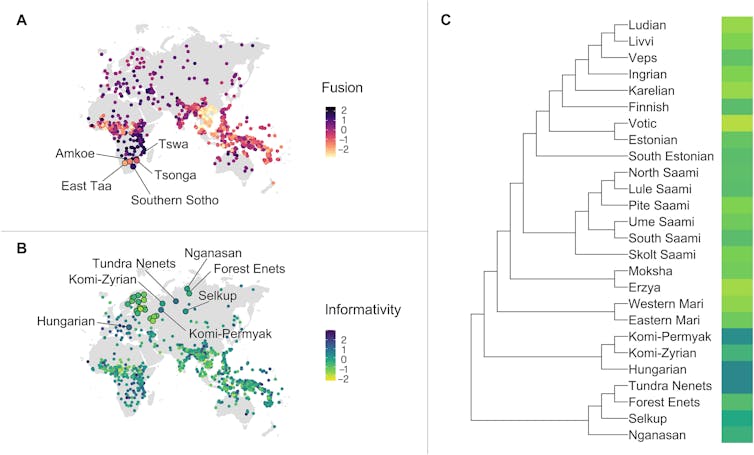
If you’ve ever seen Monty Python’s Life of Brian, you might remember that Romanes eunt domus means “Romans go home”. Or does it? Isn’t domus the nominative? Shouldn’t we be using the dative? Or is it the accusative?
Grammar is very complicated, especially if you are learning a new language. And if lots of people have to learn a new language, wouldn’t it be easier to make things simpler?
This is an intriguing idea linguists have previously proposed: languages lots of people learn as adults should tend to change over time to have simpler grammar, to accommodate the needs of learners who lack children’s sponge-like facility for picking up a new lingo.
However, in a new study in Science Advances, we analysed more than 1,200 languages to show this idea is not true, dashing the hopes of language learners worldwide.
How many words for ‘the dog’ do you need?
The theory of grammatical simplicity and non-native speakers has thrived because it seems intuitively reasonable.
Just as more non-native speakers should lead to simpler grammar, languages primarily spoken by native speakers should become more complex. This is because children can readily learn arbitrary grammatical rules and, as we collectively become more familiar with a language, we can encode more information in language more efficiently.
For example, in the relatively isolated language of Iceland, there are three different word forms for “the dog”, depending on what the dog is doing in a given sentence: hundurinn, hundinn and hundinum (the nominative, accusative, and dative forms, respectively). But speakers of Swedish, Danish, and Norwegian, three countries historically in more regular contact with each other, simply use hunden in all scenarios.
It’s nice to think we can bend our language rules to accommodate newcomers and neighbours. But is this example just an anecdote, or does it indicate a universal feature of language change where languages evolve in different ways depending on who speaks them?
Putting the theory to the test
To test this theory we used a global database of grammatical features called Grambank.
From the database, we created two measures of grammatical complexity for each language: fusion, which depends on how much the language uses features such as prefixes and suffixes, and informativity, which shows how many pieces of grammatical information must be present for sentences to make sense.

Using these measures, we modelled the relationship between complexity, social and demographic factors (such as numbers of native and non-native speakers), and language status (such as whether the language is a national language or is used in education).
We also took into account the historical origins of languages. For example, French and Italian are similar because both descended from Latin. This process creates “trees” of languages, like the picture of the Uralic languages family above.
Grammar changes more slowly than populations
Our results show how language complexity evolved alongside the number of native – and non-native – speakers of each language. Contrary to the hypothesis, it seems that changes in grammatical complexity are too slow to be affected by the ebbs and flows of new adult speakers.
A good example of this is German, which is learned and spoken by a large number of non-native speakers who must navigate its case system, three genders, verbal agreement, and a multitude of other grammatical distinctions. For example, anyone learning German needs to remember whether every single noun is masculine, feminine, or neuter, like the feminine fork (die Gabel), the masculine spoon (der Löffel), and the neuter knife (das Messer).
Read more: Research on 2,400 languages shows nearly half the world's language diversity is at risk
Instead, we found the patterns of grammatical complexity we observe today are more likely to have arisen through a combination of historical language change and contact with other languages.
Our study shows how large-scale datasets and rigorous methods can shed new light on long-standing questions about what makes grammar more or less complex.
And although we found no evidence for the impact of non-native language speakers on grammatical complexity, there are still many more questions to explore about how social and demographic changes might influence the way we communicate with each other.
The authors do not work for, consult, own shares in or receive funding from any company or organization that would benefit from this article, and have disclosed no relevant affiliations beyond their academic appointment.
This article was originally published on The Conversation. Read the original article.







